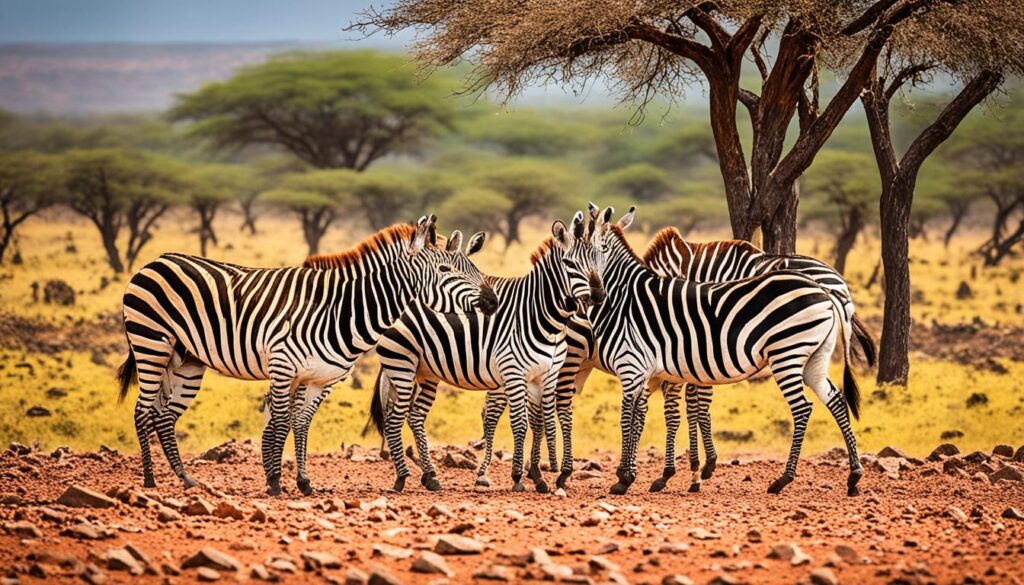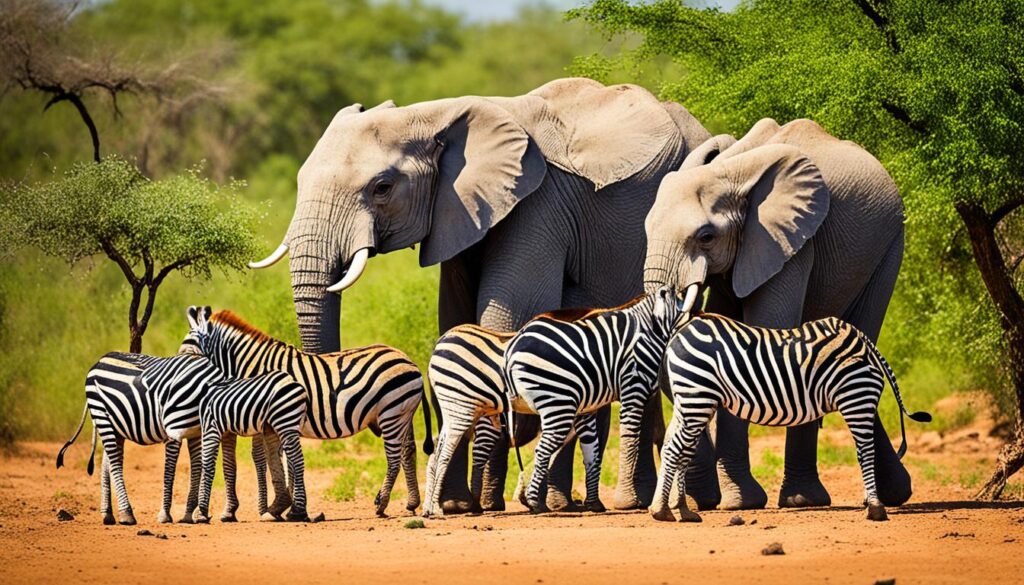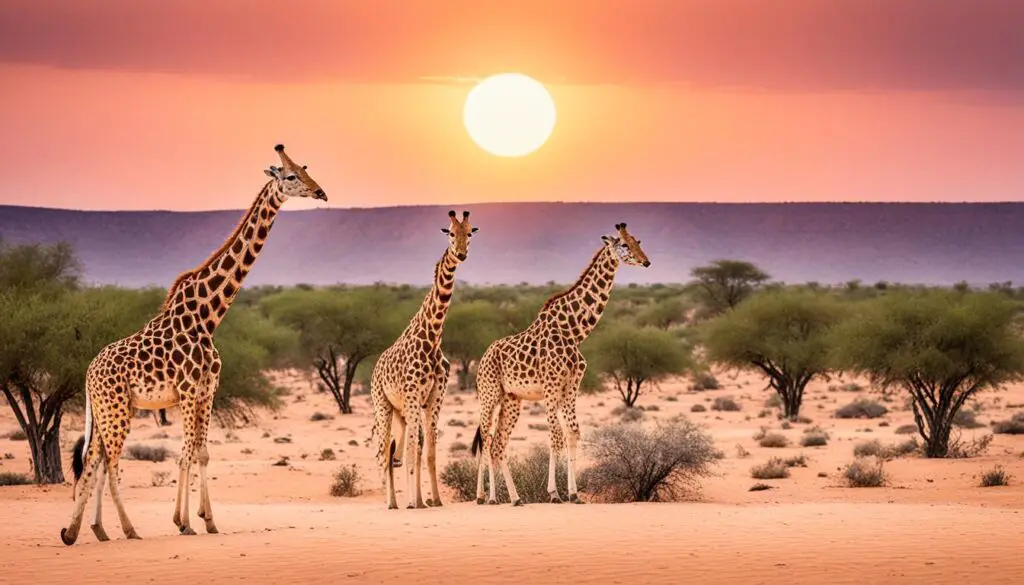Did you know that Mali is home to over 1,000 species of animals, making it a haven for Maldivian wildlife? This West African country is teeming with diverse flora and fauna, boasting a rich biodiversity that is sure to captivate nature lovers and conservation enthusiasts alike.

Key Takeaways:
- Mali is home to more than 1,000 animal species, showcasing its remarkable biodiversity.
- The country’s diverse habitats, including the Saharan, Sahelian, and Sudan-Guinea Savanna zones, provide ideal conditions for a wide range of wildlife.
- Protected areas in Mali cover about 6.2% of the country’s total area, safeguarding important habitats for vulnerable species.
- Threats such as habitat loss, poaching, and desertification pose challenges to wildlife conservation efforts in Mali.
- The cultural significance of wildlife in Mali is intertwined with traditional beliefs and practices, emphasizing the need for conservation and preservation.
Vegetation Zones in Mali
Mali, located in West Africa, showcases a remarkable diversity of vegetation zones across its vast landscape. The country is characterized by three main vegetation zones, each with its own unique characteristics, ecosystems, and wildlife.
Saharan Zone
The Saharan zone encompasses approximately one-third of Mali’s territory and is predominantly occupied by the Sahara Desert, one of the world’s largest deserts. This arid region is characterized by vast expanses of sand dunes and sparse vegetation. The Saharan zone also includes the Sahel, a transitional zone between the Sahara Desert and the Sudan-Guinea Savanna. The Sahel receives slightly more rainfall than the desert, resulting in a more varied vegetation cover, including grasslands and shrubbery.
Sahelian Zone
The Sahelian zone is the widest of Mali’s vegetation zones and stretches across the central part of the country. It encompasses the Dogon plateau and the Hombori mountains, among other prominent geographic features. The Sahelian zone experiences a semi-arid climate, characterized by irregular rainfall patterns. As a result, the vegetation in this zone consists of mixed woodland, shrubs, and grasses, providing a habitat for various animal species.
Sudan-Guinea Zone
The Sudan-Guinea zone is located in the southwestern region of Mali. It is known for its low-lying land and the Manding plateau. This zone receives higher amounts of rainfall compared to the Sahelian and Saharan zones, allowing for the development of dense forests, wetlands, and savannas. The Sudan-Guinea zone supports a diverse range of vegetation and wildlife, making it a significant ecological hotspot.
The vegetation zones in Mali are intricately connected and form a mosaic of habitats, contributing to the country’s rich biodiversity. These zones support a variety of plant species, including acacia trees, baobabs, grasses, and flowering plants. The diverse vegetation provides food, shelter, and nesting sites for a wide array of wildlife, including mammals, birds, reptiles, and insects.
| Vegetation Zone | Main Characteristics |
|---|---|
| Saharan Zone | – Sahara Desert – Sahel transitional zone |
| Sahelian Zone | – Dogon plateau – Hombori mountains |
| Sudan-Guinea Zone | – Low-lying land – Manding plateau |
Protected Areas in Mali
Mali is committed to the conservation and preservation of its natural resources, evident in the establishment of a number of protected areas throughout the country. These protected areas play a vital role in safeguarding the diverse ecosystems and rich biodiversity found within Mali’s borders. With a total area coverage of approximately 6.2% of the country’s landmass, these protected areas are crucial for the conservation of plant and animal species.
National Parks
Two national parks in Mali provide a designated sanctuary for wildlife, allowing for their protection and uninterrupted habitat. These parks are characterized by their unique landscapes and ecosystems, offering visitors an opportunity to explore and appreciate Mali’s natural wonders. They are:
- Boucle du Baoulé National Park
- Bafing National Park
Biosphere Reserve
One biosphere reserve in Mali has been designated as an important site for conserving biodiversity and promoting sustainable development. This reserve aims to harmonize the preservation of natural resources with the needs of local communities. The biosphere reserve is:
- Bandiagara Escarpment Biosphere Reserve
Faunal Reserves
Six faunal reserves in Mali focus specifically on protecting and managing wildlife populations. These reserves serve as important habitats for a variety of animal species. The faunal reserves in Mali are:
- Bafa Lake Faunal Reserve
- Falémé Faunal Reserve
- Debo-Tam Faunal Reserve
- Sambre Boulemsi Faunal Reserve
- Djenné Faunal Reserve
- Aigle de Bonikélé Faunal Reserve
Sanctuaries and World Heritage Sites
Two sanctuaries in Mali provide protection for specific species, including one that is recognized as a UNESCO World Heritage Site. These sanctuaries are:
- Gourma Chimpanzee Sanctuary
- Agoufou Sanctuary (UNESCO World Heritage Site)
Game Reserves
Six game reserves in Mali are designated areas for wildlife conservation and sustainable hunting practices. These reserves contribute to the management and preservation of Mali’s diverse animal populations. The game reserves in Mali are:
- Kouroukoro Game Reserve
- Kenta Game Reserve
- Mougaladou Game Reserve
- Bokorè Game Reserve
- Douentza Game Reserve
- Bankon Game Reserve
Ramsar Sites
Three Ramsar Sites in Mali have been designated as wetlands of international importance. These sites are essential for supporting a variety of wetland species and ecosystems, contributing to global biodiversity conservation efforts. The Ramsar Sites in Mali are:
- Lake Débo
- Djoudj Wetlands
- Djenné-Diomboro-Douentza Wetlands
These protected areas in Mali are established and regulated under legal acts to ensure the preservation of the country’s natural heritage for future generations to enjoy.

Wildlife in Mali
Mali is a country known for its rich and diverse wildlife. With its unique ecosystems and protected areas, Mali provides a habitat for a wide variety of animal species.
Mammals in Mali
Mali is home to 146 species of mammals, showcasing the country’s biodiversity. Among these species are several endangered animals, including the African wild dog, addax, and rhim gazelle. These mammals play a vital role in maintaining the ecological balance of Mali’s diverse habitats.
Birds in Mali
The avian population in Mali is equally impressive, with 622 recorded bird species. Mali provides a haven for various bird species, such as the majestic Goliath heron and the vibrant Mali firefinch. These birds contribute to the natural beauty and ecological diversity of the country.
Reptiles in Mali
Mali is also home to a fascinating array of reptiles. From the venomous desert horned viper to the resilient African spurred tortoise, reptiles thrive in Mali’s diverse landscapes. These reptiles play a crucial role in the ecosystem as predators and contributors to the balance of nature.
With its diverse wildlife, Mali offers nature enthusiasts and researchers a unique opportunity to explore and study the intricate web of life that exists within the country’s borders.

The image above illustrates the beauty and diversity of wildlife found in Mali, showcasing the importance of conservation efforts to protect these remarkable species.
Threats to Wildlife in Mali
Wildlife in Mali is facing a range of threats that jeopardize the delicate balance of its ecosystems and endanger numerous species. The following factors pose significant challenges to the survival and conservation of wildlife in Mali:
Habitat Loss
One of the major threats to wildlife in Mali is habitat loss, primarily caused by deforestation, overgrazing, and prolonged drought. These environmental factors disrupt the natural habitats and food sources of many animal species, leading to a decline in their populations and overall biodiversity.
Poaching
Poaching remains a critical issue in Mali, particularly for iconic animals such as elephants, giraffes, and lions. These magnificent creatures are targeted for their ivory, skins, and other body parts, driven by illegal wildlife trade and the demand for exotic products. Poaching activities not only decimate populations but also disrupt the ecological balance within their respective habitats.
Desertification
The encroachment of the desert and desertification further exacerbate the threats faced by wildlife in Mali. As arid areas expand and fertile lands transform into barren wastelands, flora and fauna struggle to survive in these inhospitable conditions. Desertification is a gradual process caused by natural and human-induced factors, such as climate change and improper land use practices.
Conservation efforts are crucial for mitigating the threats to wildlife in Mali and protecting the country’s rich biodiversity. By addressing the causes of habitat loss, strengthening anti-poaching measures, and implementing sustainable land management practices, Mali can ensure that its unique animal species continue to thrive for generations to come.
Cultural Significance of Wildlife in Mali
Wildlife in Mali holds immense cultural significance, deeply intertwined with traditional beliefs and practices. The people of Mali have a deep connection to the natural world, and many animals are considered sacred and symbolic in their culture.
For example, the lion is revered for its power and represents strength and bravery in Malian culture. It is often associated with leadership and is considered a guardian figure. Similarly, the elephant is highly esteemed and represents wisdom, intelligence, and longevity. These animals hold a special place in Malian folklore, art, and traditional ceremonies.
Indigenous communities in Mali have relied on wildlife for their livelihoods and traditional practices for generations. The sustainable use of wildlife resources has been an integral part of their cultural heritage, and their knowledge and practices have contributed to the preservation of ecosystems.
However, the rapid changes in the environment and the modern challenges faced by wildlife have prompted conservation efforts in Mali. The country recognizes the importance of protecting not only the biodiversity but also the cultural heritage associated with wildlife.
Conservation Efforts
To safeguard the cultural significance of wildlife in Mali, numerous conservation organizations and government initiatives are actively working to promote sustainable development and preserve the natural resources.
These efforts include:
- Engaging indigenous communities in conservation programs, integrating traditional knowledge with scientific approaches to resource management.
- Establishing protected areas and wildlife reserves to conserve critical habitats and provide sanctuary for endangered species.
- Implementing laws and regulations to combat poaching, habitat destruction, and the illegal wildlife trade.
- Conducting research and monitoring programs to better understand and protect the diverse wildlife species in Mali.
Through these combined efforts, there is hope for the preservation of both the natural and cultural heritage of Mali. By valuing and respecting the cultural significance of wildlife, these conservation initiatives aim to ensure a sustainable future for both the indigenous communities and the diverse wildlife species in Mali.
| Organization | Mission | Website |
|---|---|---|
| Association Malienne pour la Sauvegarde de la Faune et la Flore (AMASF) | Dedicated to the conservation and protection of wildlife and their natural habitats in Mali. | www.amasf-mali.org |
| Mali Elephant Project | Focuses on the conservation of elephants and the livelihoods of local communities in Mali. | www.malielephantproject.org |
| African Wildlife Foundation | Works with local partners to protect critical wildlife habitats and support community conservation efforts in Mali. | www.awf.org |
| World Wildlife Fund (WWF) Mali | Collaborates with communities and stakeholders to conserve Mali’s unique wildlife and ecosystems. | www.worldwildlife.org |
Wildlife Conservation in Mali
Wildlife conservation plays a pivotal role in Mali, with the country demonstrating a strong commitment to protecting its natural resources. The management of protected areas is vital to safeguard biodiversity and mitigate the threats of habitat loss. Mali has implemented various measures to ensure the effective management of these protected areas, including the establishment of national parks, biosphere reserves, and game reserves.
Conservation organizations, both local and international, actively collaborate with the government to promote wildlife conservation and sustainable resource management in Mali. These organizations work tirelessly to raise awareness, conduct research, implement conservation strategies, and provide technical assistance. With their expertise and dedication, significant progress has been made in preserving the country’s unique wildlife and ecosystems.
Protected Area Management in Mali
The effective management of protected areas is crucial for wildlife conservation in Mali. These areas serve as havens for endangered species, protect critical habitats, and contribute to the overall ecological health of the country. The Malian government, in collaboration with conservation organizations, focuses on implementing sustainable management practices to ensure the long-term viability of these protected areas.
- Conservation Planning: Developing comprehensive conservation plans that prioritize the protection of species and ecosystems, identify threats, and establish conservation goals.
- Law Enforcement: Enhancing enforcement efforts to combat poaching, illegal wildlife trade, and other activities detrimental to the conservation of biodiversity.
- Community Engagement: Involving local communities in conservation activities through education, capacity building, and sustainable livelihood initiatives.
- Research and Monitoring: Undertaking scientific research and monitoring programs to assess the health of wildlife populations and better understand their ecological requirements.
This integrated approach to protected area management ensures the effective conservation of Mali’s precious wildlife and promotes sustainable development practices.
Conservation Organizations in Mali
A multitude of conservation organizations contribute to the efforts of wildlife conservation in Mali. These organizations work collaboratively with the government and local communities to protect endangered species, conserve habitats, and promote sustainable resource management. Below is a list of key conservation organizations in Mali:
- Association Malienne pour la Conservation de la Faune (AMCF)
- Foundation for World Wide Nature (FONDWEN)
- Wildlife Conservation Society (WCS)
- African Wildlife Foundation (AWF)
- International Union for Conservation of Nature (IUCN)
- Mali Elephant Project (MEP)
Through their combined efforts, these organizations contribute significantly to wildlife conservation in Mali and play a vital role in protecting the country’s rich biodiversity for future generations.
| Protected Area | Location |
|---|---|
| Boucle du Baoulé National Park | Southwest Mali |
| Gourma Biosphere Reserve | Eastern Mali |
| Timbuktu National Park | Northern Mali |
| Wongozi Strict Nature Reserve | Western Mali |
The table above showcases a selection of protected areas in Mali. These areas are home to a diverse range of plant and animal species, making them crucial for wildlife conservation in the country.
Conclusion
Mali, with its diverse range of animals and varied vegetation zones, is a country rich in wildlife and biodiversity. However, the conservation of these precious resources is crucial to combat the threats they face. Habitat loss resulting from deforestation and overgrazing, poaching of endangered species, and the encroachment of the desert all pose significant challenges to wildlife in Mali.
To mitigate these threats, wildlife conservation efforts in Mali must be prioritized. It is essential to involve local communities and organizations in conservation initiatives, fostering a collaborative approach to protect and preserve the unique wildlife and biodiversity of the country.
By establishing and managing protected areas, Mali can provide habitats for a wide variety of plant and animal species. Conservation organizations, both local and international, play a vital role in supporting these efforts and promoting sustainable resource management.
In conclusion, safeguarding the animals of Mali and their habitats is crucial for the preservation of the country’s biodiversity. Through effective wildlife conservation, Mali can ensure the long-term survival of its diverse range of species and protect the cultural and ecological heritage for future generations.
